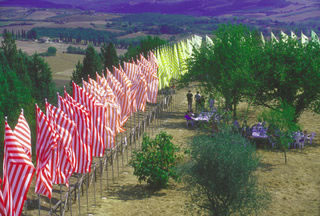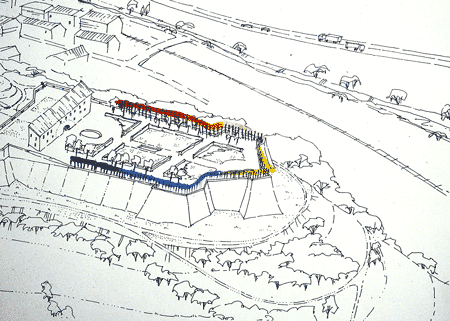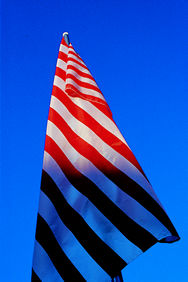 |
Polygon for
Poggibonsi
Daniel Buren held his first one-man show in Italy, at the Galleria Apollinaire
run by Guido Le Noci. On that occasion the artist, polemical with regards
to the commercial system of art as well as to the rules imposed on art
by official exhibition spaces, "closed" the gallery with a cloth
that had vertical stripes: a pattern that stood for the crisis in painting,
in representation, in the rhetoric of the "genius" culture and
its ability to operate. Le Noci took the suggestion literally and really
closed his gallery, thirty years ahead of analogous operations in the
Nineties. His shows, just like Buren’s works, began to travel freely
in lived-in spaces and to mix with the urban environment. As for the French
artist, he continued to study the possibilities offered by the exploration
of different contexts, from scraps of industrial archaeology right up
to the courtyard of the Palais Royal in Paris.
Buren’s work for Arte all’Arte also belongs to this logic of
reinterpreting the environment. He chose to work at the Cassero in Poggibonsi:
a military fortress designed by Giuliano da Sangallo and prototype of
the Forte Belvedere in Florence. So, it is a place built for military
purposes, surrounded by strong walls.: Buren outlined the fortified area in front of the Cassero with a series
of flags arranged in the shape of an arrow: a form that also has war associations
but that the artist transforms into a giant greeting of peace. The flags
are arranged along the fortress walls, that is to say along the area that
is, visually, most aggressive. On three sides of the perimeter, the artist
has raised 153 steel flagpoles, six meters high, to which the same number
of banners are attached and move freely in the wind. If the colors of
war are dark and mimetic, those of peace should be happy and visible:
in fact Buren has chosen colors that cover the whole chromatic spectrum
and naturally all the flags have vertical stripes. Standing inside the
fortress, the visitor finds himself inside a light but imposing polychrome
fence that separates him from the rest of the world. With the nut trees
and peach trees growing in the flat field (located next to a sheer drop
of the hillside) the installation emphasizes the tranquillity of the place.
Instead, looking at the work from outside, one notes how the defensive
architectural structure becomes more visible, even to the point of showing
viewers a happy rainbow that can be seen from the via Cassia, from the
Siena-Florence highway and more secondary roads.
Buren outlined the fortified area in front of the Cassero with a series
of flags arranged in the shape of an arrow: a form that also has war associations
but that the artist transforms into a giant greeting of peace. The flags
are arranged along the fortress walls, that is to say along the area that
is, visually, most aggressive. On three sides of the perimeter, the artist
has raised 153 steel flagpoles, six meters high, to which the same number
of banners are attached and move freely in the wind. If the colors of
war are dark and mimetic, those of peace should be happy and visible:
in fact Buren has chosen colors that cover the whole chromatic spectrum
and naturally all the flags have vertical stripes. Standing inside the
fortress, the visitor finds himself inside a light but imposing polychrome
fence that separates him from the rest of the world. With the nut trees
and peach trees growing in the flat field (located next to a sheer drop
of the hillside) the installation emphasizes the tranquillity of the place.
Instead, looking at the work from outside, one notes how the defensive
architectural structure becomes more visible, even to the point of showing
viewers a happy rainbow that can be seen from the via Cassia, from the
Siena-Florence highway and more secondary roads.
|
|



